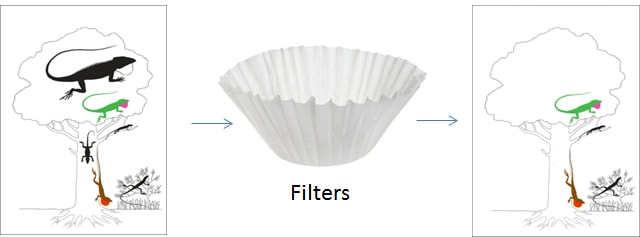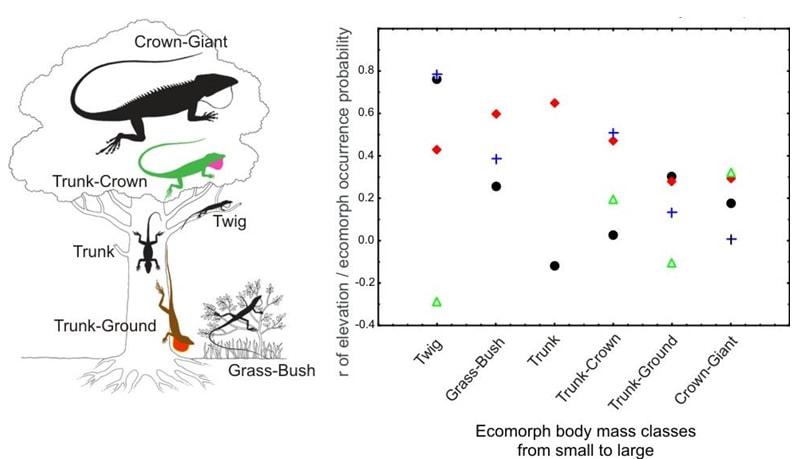what makes anolis ecomorph communities complete?This blog post was originally published on Anole Annals: One of my favorite graphic representations of a typical anole community is the one where all ecomorphs are hanging out together in a tree and a scrub next to said tree. Each ecomorph has its structural microhabitat place and they are all spaced out evenly across the tree to represent competition. Originally the figure was published by Williams (1983) and then modified later on. Arriving on the Greater Antilles, one thus expects to promptly be able to say hi to all these ecomorphs at the next best tree. Well, from my personal experience, I can tell you that this is unfortunately not the case. Localities where all ecomorphs are found together are scarce, and all of them are famous, having served as field sites for the most ground-breaking of anole discoveries. But what about the rest of them? Something must prevent the co-occurrence of ecomorphs in all these other places. This was noted before: Losos (2009) remarked that all utilized structural microhabitats exploited by all ecomorphs are present throughout the islands, so “complete” ecomorph communities should also be able to occur everywhere. A common explanation for the absence of certain “functional types” (= Anolis ecomorphs) from local communities is a process that is called “filtering.” Modern community assembly theory distinguishes two such types of filters: 1. Biotic interaction filters and 2. Environmental filters. Biotic filtering involves competitive exclusion: For anoles this phenomenon caused ecological speciation which led to the convergent evolution of the ecomorph communities. But biotic filtering should not be expected to occur at this stage of the radiation: Different ecomorphs are not competing for the same structural microhabitat niche in different localities. This leaves environmental filtering. In our study published in Ecology and Evolution, on which I am reporting here, we tested whether environmental filtering could be a possible explanation for the absence of ecomorphs in local communities. First, we modelled Anolis ecomorph community completeness by constructing environmental niche models for each ecomorph (the sum of species belonging to that ecomorph) on each island. These models were then overlaid for all ecomorphs per island. The map for ecomorph community completeness shows a very patchy distribution of areas where all ecomorphs are expected to occur. Comparisons of environmental niches among these islands revealed that only Hispaniola and Cuba have their complete Anolis ecomorph communities occurring in a similar bioclimatic parameter space. This patchiness could be explained by elevation for all islands except Jamaica: the Anolis community completeness map strongly resembles the topographic relief of the Greater Antilles. Looking more closely into the climatic parameters, Jamaica has much lower daily and annual temperature ranges which are also not related to the island’s elevation, whereas in the rest of the Greater Antillean islands, they are. Occurrence probability of ecomorphs seems to be coupled to environmental parameters, which explains why some ecomorphs are “filtered out“ in some locations: they do not encounter a favorable environment there. Since I mentioned initially that filtering relates to “functional types” (not species), the filtering must be a result of certain functional properties of the Anolis ecomorphs’ phenotype. We wanted to take the study a step further and actually investigate one (among many) possible functional trait: body mass. Body mass is a known functional trait in animals and has been found to explain metabolic rate variation in squamate reptiles which is in turn possibly related to thermal physiology. Thermal physiology could determine the parameters of an animal’s functional environmental niche Also, Anolis ecomorphs strongly vary in body mass. In this paper, we identified a significant correlation between environmental filtering of Anolis ecomorph community assembly and ecomorph body mass as a functional trait: Smaller ecomorphs with lower body mass are restricted to higher elevations (where it is colder), while larger ecomorphs are found toward warmer environments (usually found in lower elevations). The Jamaican twig ecomorph Anolis valencienni was the only species included in our study that did not follow the overall pattern.
In conclusion, our results in Anolis expand the understanding of community assembly within insular adaptive radiations of animals. The current consensus is that biotic filters are of importance for their evolution, while environmental filters mostly influence species composition. Here, we could show that environmental filtering of functional traits independently from species composition is a major determinant for local community assembly, and future research should be directed toward investigating the importance of these filters in other adaptive animal radiations. You can see the full paper here (Open Access): http://onlinelibrary.wiley.com/doi/10.1002/ece3.908/abstract;jsessionid=8A448C88B0149BAF4244B42D098A2765.f04t02
0 Comments
Leave a Reply. |
Details
Kat / other membersWe'll update you on news from our research and other related activities Archives
March 2022
Categories |





 RSS Feed
RSS Feed
